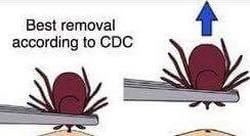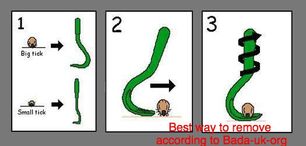HOW TO SAFELY REMOVE A TICK!
What does the tick look like?
The stages, by day as stated on the picture, can go faster!
The stages, by day as stated on the picture, can go faster!

It normally takes about 48 hrs for the tick to transmit the bacteria into the dog that causes disease and can potentially make your dog sick!
However, according to the Bada- Lymes website UK, the tick can regurgitate if the tick is agitated!
After walks through the woods or tall grass it is highly recommended to give your dog a thorough comb over to remove ticks. Some people use lint rollers to remove loose ticks, but this method will not remove any biting ticks.
There are lots of old wife tales about how to remove a tick. Most of these require to do something to the tick, This however is not recommended as it will encourage the tick to omit the toxin/bacteria (regurgitate) that could cause the Lymes or Lyme related disease!
Never smother, burn, or touch the tick other than to pull it out..

The best way (according to the CDC website) with the least chance for the head to stay in the body is to pull it out in an upward firm, slow motion. Fine tipped tweezers work the best.. Handling the tick by the body might cause it to rupture and to gorge the bacteria into the dogs body.

There are 2 tick tools available, larger and smaller, choose the tool that is suitable for the tick.
Approaching from the side as a small tick is harder to grab, securely get the tick in the tool, lightly lift and turn tool about 3 times around till the tick lets go!
When you have the tick out , put it in a glass with water, burn it, or any other method of elimination.. Please know: A tick after feeding will then lay eggs, 100’s of eggs. Dispose of the tick in a way you know the tick is dead.
After the tick is removed clean the affected spot with apple cidar vinegar or any other antiseptic. If the head is left in ( it happens a lot) an anti-bacterial cream like Calendula cream and keep a good eye on that spot. You could potentially bring the tick to the vet for testing (some vets do, some don’t) or save it for testing if your dog would become sick.
After the tick is removed clean the affected spot with apple cidar vinegar or any other antiseptic. If the head is left in ( it happens a lot) an anti-bacterial cream like Calendula cream and keep a good eye on that spot. You could potentially bring the tick to the vet for testing (some vets do, some don’t) or save it for testing if your dog would become sick.


 RSS Feed
RSS Feed